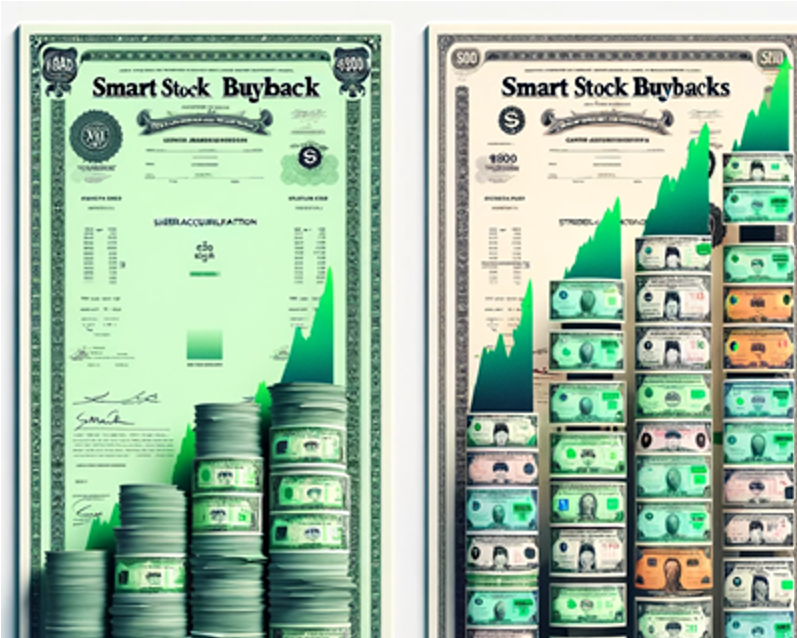When companies buy their own shares back, they're saying they believe their stock is a good deal. This can be great for you as an investor because it might mean the company is doing well and thinks its share price will go up. But not all buybacks make them a good investment. Some can be tricks to make the company look like a better investment than it is.
Let's dive into how you can tell the difference and find the smart buyback that could make you money.
Understanding Stock Buybacks
Think of stock buybacks as a company buying itself. It buys its own shares from the market.
This can be a good sign because it often means the company has extra cash and thinks its stock price is too low. It is the same as if you found your favourite snacks on sale and bought more because you know they're worth more.
But, just like snacks, just because a company buys back its stock doesn't always mean it's a great deal.
Sometimes, companies do it for the wrong reasons. That is why it's important to know why a company is buying back shares.
The Good: Signs of Smart Buyback Programs
First, look for companies that keep buying back shares over many years. This shows they really believe in returning cash to shareholders.
Next, check if the company buys shares when prices are low. This means they are smart about getting a good deal.
Also, look to see if the company's total number of shares goes down because of buybacks. This means you could profit as your shares could be worth more.
The Bad: Red Flags in Buyback Programs
Be careful of companies that only buy back shares occasionally. This might not really add value and may just be management propping up the share price or jumping on a current market fad.
Watch out if a company buys its shares when prices are already high. This might mean they're not making the best decisions with their money and am most likely only trying to keep the stock price high. Perhaps to sell their stock options at a high price.
Lastly, if the company is buying back shares but the total number of shares isn't going down, they might just be trying to make things look better than they are by buying back shares issued because of options given to management.
Click here to start finding companies that are making Smart Buyback decisions NOW!
How to Analyse Buyback Programs
To really understand buybacks, look at how much the company is spending on buybacks compared to its overall value.
This is called the buyback yield. A high yield can be a good sign.
But also, check if the company has not already got too much debt and if it is undervalued. Look at the company’s debt to equity or debt to free cash flow levels. And for valuation its price to earnings, price to book or Value Composite valuation.
Practical Steps to Find Companies Making Smart Buyback Decisions
Leverage Stock Screeners
Start by using a stock screener like Quant Investing, which allows you to filter companies based on their buyback yield. This means you can quickly find companies that are actively buying back a lot of their stock, indicating they might believe the stock is undervalued.
You can read more here: How to find companies doing smart stock buybacks
Look at Debt Levels
Focus on companies with low levels of debt. In the screener, you can filter for companies within the lowest 40% in terms of net debt to EBIT (earnings before interest, taxes, depreciation, and amortization). This ensures the company is not just financially stable but also smart about its buybacks.
Global Reach
Don’t limit your search to one country. Look for companies in all major developed stock markets worldwide. This broadens your potential investment pool which lets you find the best companies that meet your screening criteria and diversifies your risk.
Trading Volume
Ensure the company has a minimum 30-day average traded value of $100,000. This helps you avoid investing in companies that are hard to buy or sell.
Valuation Metrics
Look beyond the buyback yield. Using a screener, select companies with a high Buyback Yield but also a low Qi Value or Value Composite score. This combination helps you find companies that are not only buying back shares but are also undervalued based on a few valuation ratios. .
Quality Check with Piotroski F-Score
To add another layer of quality to your selection, look for companies with a Piotroski F-Score greater than 6. The F-Score helps you find companies that are financially strong and less likely to encounter financial distress.
Verify and Research
Once you've identified potential buyback investment ideas do your due diligence. Read the latest company reports and news to ensure there haven't been significant changes that could affect your investment decision. Remember, a screener is a starting point, not the end of your research.
By following these steps, you can systematically find companies making smart buyback decisions.
Conclusion
Not all stock buybacks are created equal. By understanding the signs of a good buyback program and how to spot the red flags, you can make smarter investment decisions.
Remember, a company buying back its own stock should be doing it for the right reasons.
With a bit of research and the right tools, you can start finding companies that are making smart buyback decisions, which means higher returns for you.
Click here to start finding companies that are making Smart Buyback decisions NOW!


